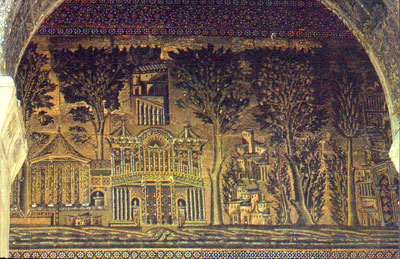Barada Panel in Great Mosque in Damascus


Annotation
The panel shown here is five meters (16.7 feet) above ground level on the wall in the courtyard of the Great Mosque in Damascus. The original image is created in mosaic technique. Choosing to execute an image in mosaic involves setting thousands of small pieces of glass, ceramic, or stone into mortar. In antiquity (the technique was invented in the Mediterranean basin in about the 4th century BCE), the individual pieces used to compose the mosaic were usually of standard size. As the technique gained in popularity and spread, mosaics were often made of pieces of different sizes and shapes like the pieces of a puzzle. Mosaic is a difficult technique requiring extraordinary time and labor and can be used on the exterior of a structure, but is most frequently used on interior or partially covered areas, often to protect the mortar. When we analyze an intricate image such as this mosaic, historians often pay as much attention to the many trained artists who made this image as we do to the content of the image itself. Paying attention to the ways that a wall was transformed into a luminous landscape by the application of hundreds of thousands of glass cubes tells us much about the technological and artistic skill as well as the resources and cultural values of a given society.
This source is a part of the Analyzing Photographs methods module.